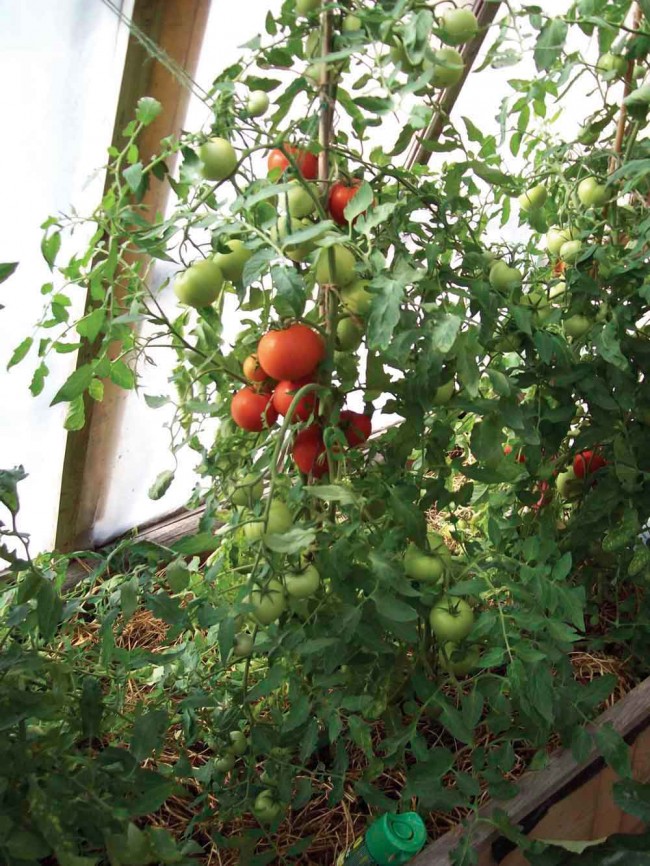
Photo Credit: Andy Pollock
Growing the Northern Tomato
If a northern gardener is going to be caught bragging, chances are good that it will be about their tomatoes. Homegrown tomatoes are one of the many pleasures of summer and whether you start them from seed or buy them from the farmers’ market, nothing beats the flavour of a sun-ripened tomato. Although they are a heat-loving plant, it is still possible to grow the luscious fruit in our cooler climate.
Andy Pollock, from Houston, BC, has not only grown tomatoes, he has spent 40 years breeding his very own strain with hardiness, fruit production and flavour in mind. The Pollock tomato is an indeterminate, or vine, tomato that can withstand frost.
“I’ve had more than one person tell me, ‘There’s no way you can grow a hardy tomato—they’re a tropical plant.’ Well, I did it,” he says, “and you can’t argue with success.”
Pollock describes the humble beginnings: “I grew (Bonny Best, a variety suited to short, cool growing seasons) and the next spring I had a volunteer that came out from where a rotten tomato fell. I thought, ‘I’m not going to pull it up, I’m just going to see what happens.’ Through the summer I watched it and it wasn’t extremely big but it had 30 tomatoes on it. They weren’t huge—about six ounces. So I saved seeds and replanted them the next year. I did that for about 10 or 12 years in Kamloops. When I moved up here I selected only the heaviest, strongest plants. Over the years, I’ve had them get bigger, sturdier and with more fruit.”
Accidental life’s work
His home in rural Houston is at about 1,000 m in elevation and subject to cooler temperatures than the valley bottom. The breeding program takes place on the side of a mountain in an unheated greenhouse.
“I usually leave the doors and the windows open in the greenhouse, even when there’s frost. My plants, the Pollocks, will survive at -2 C. Compared to other tomatoes, these will survive when others die.”
Keeping track of the best plants and selecting for the desirable traits by hand takes careful observation and patience.
“I’ll put a flag on the first plants that set buds, I’ll put a second flag on the first ones that sets flowers, and I’ll put a third flag on the first ones that sets fruit. Only three or four plants will have all three flags. I only save seeds from the first three fully vine-ripened tomatoes. When I clean them I spread out the seeds on a table cloth and I only select the largest seeds.” Fruit on the Pollock tomato is between eight and 10 ounces each on unpruned plants.
“I have had reports of tomatoes up to a pound or better and everyone has reported heavy production,” he says. “They have a tender skin, the core only goes down about half an inch and if they are fully ripe you can run a knife under the edge of the skin and peel it off without blanching.”
His tomato is well known in organic gardening circles and the seeds can be purchased from several catalogues including Annapolis Seeds, Saltspring Seeds and Sugar Shack Seeds. He calls it his “accidental life’s work” and though he has found success, he isn’t ready to quit: “I am working on a -5 hardy tomato. I have had it survive -3. … I managed to get viable seed and I’ve been keeping that strain going.”
Depending on the year, Smithers horticulturalist Carla Atherton grows between 1,700 and 2,300 pounds of tomatoes. Though she has yet to try the Pollock tomato, she says she looks forward to testing it out: “I’m thrilled to be able to get something that is local. I’m excited to try it and curious to see how it will do in my greenhouse and how its yield will be affected by my environmental conditions.”
Apart from choosing the right strain, environmental conditions have a great bearing on a tomato grower’s success. Atherton emphasizes getting to know the environment you have to work with and experimenting with different techniques, as each garden has its unique quirks. She has production down to a science and shares her knowledge by mentoring other gardeners. She offers a few quick tips for a successful yield.
Start at the bottom
Atherton says a healthy root system is where it all starts. She uses pressed soil blocks instead of pots. This method allows the roots to air prune, which prevents the plant from becoming root bound inside a pot. When the tomatoes are ready to plant in the greenhouse, she digs a trench and gently places the plant lengthways, leaving the top six inches above ground.
“I pull off all the lower leaves and bury it. The hairs on the stem will all produce roots when it is underground,” she says.
Once the plant naturally rights itself (don’t bend it!), she attaches it to the trellis. The additional root mass helps feed the plant through the season. Watering the plants deeply (so the earth is soaked to a depth of six to eight inches) but infrequently draws the roots down into the soil, helping them reach nutrients deeper down. Atherton prefers a wholistic approach by building up soil nutrients with compost rather than adding a lot of fertilizer.
Climate control
“When I’m planting in my greenhouse, I make sure that it isn’t too warm,” Atherton says, emphasizing the importance of temperature and moisture control. An automatic ventilation system keeps the greenhouse between 24 and 27 C. At 32 C, without enough ventilation, the plants will stop growing.
Humidity control is also vital: “Getting airflow is really important for controlling disease. The biggest diseases that can be avoided are early and late blights, which has so much to do with the moisture in your greenhouse,” Atherton says about the disease that produces brown to black target-like spots on older leaves and, if severe, attacks the stems and fruit.
“You should remove all diseased plant tissue, space the plants farther apart to improve air circulation, and avoid overhead irrigation,” She says.
Less is more
Pruning is one of those things that just feels wrong. However, pruning tomatoes correctly can divert energy from the production of foliage to the production of fruit.
“Once the first set of trusses (bunch of fruit) starts to develop, I start pruning off the bottom branches. Then, when the next set of trusses from the bottom starts, I prune whatever is under that set. There are still lots of leaves above for photosynthesis and shade. The goal is getting that foliage up and getting the airflow underneath,” she says.
Atherton also advises to learn whether your tomato is determinate (bush) or indeterminate (vine) as bush tomatoes require less pruning. Whatever you do, don’t chop off the leader!
Learning from friends or neighbours is an important part of growing local food; there are many experts who are happy to share their secrets. Though often modest, those champion tomato growers are proud of their exploits and want others to be successful as well. While it may take years to win a ribbon at the fall fair (if ever), growing tasty, homegrown tomatoes is within reach of any willing and diligent gardener.







